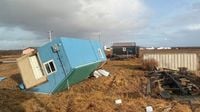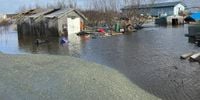As dawn broke over western Alaska on Sunday, October 12, 2025, the devastation left by the remnants of Typhoon Halong became painfully clear. Communities stretching from the Kuskokwim Delta to the shores of the Bering Sea faced a scene of chaos and heartbreak, as residents documented the storm’s aftermath with photos and messages shared online—when they could get a signal. According to the Alaska Beacon, hurricane-force winds reaching up to 107 mph and a massive storm surge battered remote villages, many of which are only accessible by small plane or snowmobile. For many, the storm’s impact was nothing short of catastrophic.
In Kipnuk, a coastal village of about 700 people, Jacqui Lang described on Facebook how “several houses floated miles inland—some with people still inside. There are a few houses still intact on higher ground on one side of the village. Everyone else has lost their homes or are facing extensive damage.” Social media, despite spotty connectivity, became a lifeline for sharing prayers, updates, and pleas for help. Residents posted videos of U.S. Coast Guard helicopters rescuing neighbors from homes adrift in floodwaters. Kristy Fox of Kipnuk shared a dramatic update: “WE MADE IT OUT OF KIPNUK! Everyone’s good and at the school. The Coast Guard just picked us up and just landed into Bethel. Kipnuk isn’t Kipnuk anymore. I pray they evacuate safely.”
Rescue efforts were swift but daunting. Search-and-rescue teams from the Alaska Army National Guard, Alaska’s Air National Guard, and the U.S. Coast Guard descended on the hardest-hit villages, including Kipnuk and Kwigillingok. According to the Associated Press and Weather Channel, at least 51 residents and two dogs were rescued from these two communities alone on Sunday and Monday. But the toll was heavy: one woman, 67-year-old Ella Mae Kashatok of Kwigillingok, was found dead, and two men—her relatives—remained missing as of Tuesday, October 14, after extensive search operations covering 88 square miles.
Hundreds of people were forced to flee their homes as floodwaters surged. In Kwigillingok, water levels rose 6.3 feet above the highest tide, prompting the evacuation of more than 100 people to shelters. In Kipnuk, nearly 200 residents sought refuge in community shelters, with at least eight homes pushed off their foundations as water levels surged nearly seven feet. Across the region, over 1,400 people were displaced, with hundreds still waiting for evacuation as of Tuesday, according to Anchorage Daily News. The challenge of moving so many people was compounded by damaged infrastructure, including a battered airport runway in Kipnuk and a lack of shelter space in Bethel.
Governor Mike Dunleavy responded by expanding a disaster declaration, promising, “Every effort will be made to help those hit by this storm.” The Association of Village Council Presidents, representing 56 tribes in the Yukon-Kuskokwim Delta, called for federal intervention, asking President Donald Trump to declare a national emergency and send aid to western Alaska. Vivian Korthuis, the group’s CEO, wrote, “Western Alaska needs your intervention immediately, and we are ready to work with you to support our communities. Send federal aid. Help us protect lives and rebuild our communities and our future.”
The human stories behind the statistics are harrowing. Jamie Jenkins, a resident of Napakiak, told the Associated Press that the storm was “the worst I've ever seen.” She described howling winds and fast-rising waters that forced her family and neighbors to evacuate by boat to the school when floodwaters reached their top steps. “Practically the whole community” took shelter there, she recalled. In Kotlik, Adaline Pete said she had never experienced such strong winds; an unoccupied house next door was flipped over, but her family managed to stay safe.
For many, the storm’s aftermath is a jumble of loss and uncertainty. Doreen Carter, a Kipnuk resident, recounted to Anchorage Daily News how her brother called her at 4 a.m. Sunday to say her house was floating away. She later saw a Snapchat video showing the sky-blue house—her home for 20 years—stuck against a boardwalk rail as other houses collided with it. “I lost everything,” Carter said, including her snowmachine, four-wheeler, and a freezer full of subsistence foods like walrus, seal, fish, and berries. “Everybody in the community lost something.” Now, her family is scattered between the Kipnuk school, Bethel, and Anchorage, unsure if they’ll ever return. Carter worries that unless the village is rebuilt on higher ground, “there are more storms coming that are going to be worse than this.”
Emergency responders faced a logistical nightmare. Mark Roberts, incident commander for the state Division of Homeland Security and Emergency Management’s Emergency Operations Center, explained, “We’ve got a real challenge ahead of us. The volume is unprecedented.” Nearly 60 evacuees from Kipnuk and Kwigillingok spent Monday night in a shelter at the Armory in Bethel. But even as teams worked to assess damage and relocate people, the region’s remoteness and damaged infrastructure slowed progress. Roberts noted, “We have everything we need. We just can’t move it fast enough.”
Other communities, including Napakiak, Nightmute, and Kivalina, also reported hundreds sheltering as of Monday evening. The storm’s reach extended beyond the coast, with damage reported as far inland as Bethel, over 50 miles up the Kuskokwim River. Communication remained spotty, with limited phone and internet service hindering both rescue operations and families’ efforts to connect with loved ones.
State officials warned that the onset of winter would only make matters worse. Many displaced residents have no homes to return to, and officials are considering relocating some to cities like Fairbanks or Anchorage while they assess whether homes can be repaired or must be rebuilt entirely. Damage to critical infrastructure—including airport runways, water systems, and power supplies—was widespread. Some communities reported downed water and power systems or severe erosion, further complicating recovery efforts.
Despite the immense challenges, the spirit of Alaska’s communities shone through. In Kipnuk, residents salvaged what they could, sharing subsistence foods and preparing communal meals for those sheltering at the school. In Kwigillingok, people gathered in the school gym to sing devotionals in Yup’ik, finding comfort in tradition amid chaos.
As the region begins the long process of recovery, the lessons from Typhoon Halong’s remnants are clear: the vulnerability of remote communities to extreme weather is growing, and the need for resilient infrastructure and robust emergency planning has never been more urgent. For now, the focus remains on caring for the displaced, searching for the missing, and rebuilding homes—and hope—in western Alaska.





